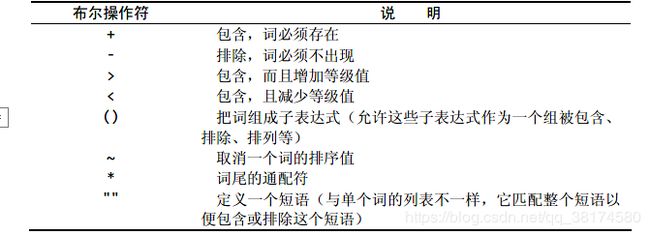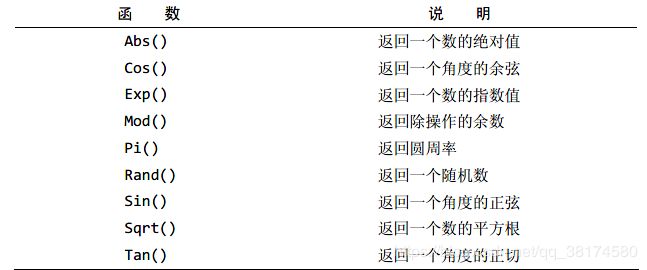MYSQL必知必会笔记
MYSQL必知必会笔记
- MySQL必知必会笔记
- 了解数据库 了解MySQL
- 检索数据
- 排序
- 过滤语句与操作符与通配符
- 正则表达式搜索
- 创建计算字段
- 数据处理函数
- 汇总数据
- 分组数据
- 使用子查询
- 联结表 组合查询
- 全文本搜索
- 插入 更新 删除数据
- 创建和操纵表
- 使用视图
- 存储过程
- 使用游标
MySQL必知必会笔记
《MySQL必知必会》学习笔记
了解数据库 了解MySQL
数据库(databass):以某种有组织的方式存储的数据集合
DBMS(Database Management System):数据库管理系统
SQL((Structured Query Language):结构化查询语言
MySQL是基于客户机——服务器的数据库
检索数据
SQL语句不区分大小写
distinct语句:只返回不同的值
select distinct vend_id ,prod_price from products ;
##distinct会应用于再它后面的所有列,所以vend_id和prod_price两个中有一个在自己列中
##是唯一的就输出该行,必须两个在自己列都不是唯一的,才不输出
limit 语句:限制结果
select prod_name from products limit 5,5;#指示返回从第5行开始的后5行
#0行为起始行
排序
order by:对检索结果进行排序(默认升序)
desc:降序排序,只对在关键词前的单个列起作用
select prod_id,prod_price,vend_id,prod_name from products order by vend_id desc,
prod_price;-- 先排vend_id,vend_id相等再排prod_price
#结果为先对vend_id进行降序排序,再对prod_price升序
以下程序用于找出最贵商品
select prod_price from products order by prod_price DESC limit 1;
(注:limit和order by 混用在重复数据多时,可能出现和预期不一样的结果,详情如下
链接文章limit和order by 混用陷阱)
过滤语句与操作符与通配符
where:根据给定条件进行过滤
select prod_name,prod_price from products where prod_price=2.5;
-- 返回prod_price值为2.5的行
BETWEEN:在两个值之间,闭区间
NOT BETWEEN:不在这两个值中 开区间(not between 5 and 10 #不会检索出5与10之间的)
select prod_name,prod_price from products where prod_price between 5 and 10;
IS NULL 语句,进行空值检查
‘ ’ :单引号用来限定字符串
select prod_name,prod_price from products where prod_name='Sling' ;
操作符:
AND:用来指示检索满足所有条件的行
OR :匹配任一条件(AND有限条件高于OR)
IN::指定要匹配的条件
select vend_id from products where vend_id in(1003,1002);
NOT:否定跟在后面的条件
通配符:
通配符:用来匹配值的一部分的特殊字符
%:表示任意字符出现任意次数
select prod_id,prod_name from products where prod_name like 'jet%';
#检索以jet开头的词,%告诉MySQL接收jet后的任意字符,不管长度
select prod_id,prod_name from products where prod_name like '%anvil%';
#检索含有文本anvil的值
下划线(_):只匹配单个字符
select prod_id,prod_name from products where prod_name like '_ ton anvil';
注:1.通配符搜索处理时间一般比较长
2.通配符置于搜索模式的开始处,搜索起来最慢
正则表达式搜索
点" .":表示匹配任意一字符
select prod_id,prod_name from products where prod_name REGEXP BINARY 'JETPACK .000';
#正则表达式不区分大小写,如需要,用BINARY来区分
LIKE和REGEXP区别:LIKE匹配整个列,REGEXP在列值内匹配,文本在列值中出现,REGEXP就会返回相应的行
个人理解:LIKE匹配整个串,REGEXP匹配连续子串
OR匹配 “|”:
select prod_id,prod_name from products where prod_name REGEXP BINARY '1000|2000';
匹配符号内的任一单一字符:[ 和 ]
select prod_id,prod_name from products where prod_name REGEXP '[123] Ton';
#匹配1或2或3 中一个就返回
select prod_id,prod_name from products where prod_name REGEXP '[^123] Ton';
#匹配除这些字符以外的
#[123]等同于[1-3],[^123]等同于[^1-3]
匹配特殊字符
select prod_id,prod_name from products where prod_name REGEXP '\\.';
#匹配特殊字符需用\\为前导
select prod_name from products where prod_name REGEXP '[[:digit:]]{4}'
#[:digit:]匹配任意数字,{4}确切要求出现4次,最后结果为连在一起的任意4位数字
select prod_name from products where prod_name REGEXP '^[0-9\\.]'
#^在集合(即[和])中表否定,否则用来指串的开始处
创建计算字段
计算字段并不实际存在于数据库表中,计算字段是运行是在SELECT语句内创建的。
Concat()函数:用来拼接两个列
select concat(RTrim(vend_name),'(',vend_country,')') from vendors order by vend_name;
#各个串之间用逗号分隔
#RTrim()函数去掉右边的所有空格,LTrim()去掉左边空格,Trim去掉串左右两边空格
使用别名:
别名:用AS关键字赋予
select concat(RTrim(vend_name),'(',vend_country,')') AS vend_title from vendors order by vend_name;
#这时任何客户机可按列明来访问
算术操作符
select prod_id,quantity,item_price,quantity*item_price AS expanded_price From orderitems where order_num=20005;
#算术操作符 + - * /
select now();#返回现在时间
数据处理函数
select cust_name,cust_contact from customers where soundex(cust_contact)=soundex('Y LIE')
日期和时间处理函数

日期格式最好为yyyy-mm-dd(最好用Date()进行查询)
select cust_id,order_num from orders where Date(order_date)='2005-09-01';
#Date(order_date)指示MySQL仅提取列的日期部分
select cust_id,order_num from orders where Year(order_date)=2005 AND month(order_date)=9;#检索出2005年9月份的所有行
#Year()是从一个日期中返回年份,Month()从日期中返回月份
汇总数据
select AVG(prod_price) AS avg_price From products;
#AVG()忽略列值为NULL的行
select AVG(distinct prod_price)AS avg_price from products where vend_id=1003;
#DISTINCT,只包含 不同的值,适用于所有聚集函数
COUNT()函数:如果指定列名,指定列的值为NULL被忽略,不计入总数,如果用 * 号则不忽略
SUM函数:
select SUM(item_price*quantity) AS total_price From orderitems where order_num=20005;
#sum()也可以用来合计计算值
组合聚集函数
MAX(prod_price)AS price_max,AVG(prod_price)AS price_avg from products;
分组数据
分组: 分为多个逻辑组,然后对每个组聚集计算
select vend_id,count(*) AS num_prods from products group by vend_id
#有group by函数表示对每个vend_id排序并分组,导致对每个vend_id进行一次num_prods计算
#否则将输出商品总数
(注:1.GROUP BY会自动分组 2.可包含任意数目的列,即多次分组(但不能使聚集函数) 3.建立了分组,将以组形式返回,不能返回单个 4.select语句中所有列都要在GROUP BY中给出,除聚集函数,5,NULL值将会作为一个分组返回 6.GROUP BY在where之后,Order by 之前)
(注:测试后,GROUP BY子句可不给出SELECT中所有子句,可根据自己需要进行分组,哪个在前就先对哪个进行分组)
过滤分组:
HAVING子句:HAVING过滤分组(WHERE过滤行或者说HAVING在分组后过滤,WHERE在分组前过滤)
select cust_id,count(*) AS orders from orders group by cust_id HAVING count(*)>=2;
#过滤COUNT(*)>=2以上的
使用子查询
子查询:嵌套select语句,将select语句返回结果用于另一条select语句的WHERE子句
子查询中子句可查询另一表中数据
(注:可多层嵌套,但是不建议过多使用,性能会下降)
select cust_name,cust_contact from customers where cust_id in(
select cust_id from orders where order_num IN(
select order_num from orderitems where prod_id='TNT2'));
#接下来给出联结的处理方式
select cust_name,cust_contact from customers, orders ,orderitems
where customers.cust_id=orders.cust_id And orderitems.order_num=orders.order_num AND prod_id='TNT2';
#select后给出要查询的信息,from后接从哪寻找信息,where后联结表,再加限定条件
创建计算字段使用子查询:
select cust_name,cust_state,(select count(*)from orders where
orders.cust_id=customers.cust_id)AS orders from customers order by cust_name;
注:本处orders.cust_id=customers.cust_id使用了完全限定列名,因为本次查询是一次相关子查询(涉及外部查询),cust_id具有二义性,所以必须使用完全限定列名
联结表 组合查询
外键:外键为某个表中的一列,它包含另一个表的主键值,定义了两个表之间的联系。
联结:一种机制,用来在一条select语句中关联表,因此称为联结。
创建联结:
两个表之间的联结,称为等值联结/内部联结
select vend_name,prod_name,prod_price from vendors,products where vendors.vend_id=products.vend_id order by vend_name,prod_name;
#from 后面列出了两个表,表用where语句正确联结
select vend_name,prod_name,prod_price from vendors inner join products on vendors.vend_id=products.vend_id;
#采用 INNER JOIN 语法的联结形式
联结多个表
注:联结表越多,性能下降越厉害
select prod_name,vend_name,prod_price,quantity from orderitems,products,vendors
where products.vend_id=products.prod_id and order_num=2005;
#多个表联结
自联结:
自联结在某些情况下比子查询快
select p1.prod_id,p1.prod_name from products AS p1,products AS p2
where p1.vend_id=p2.vend_id and p2.prod_id='DTNTR';
#用于查询某个产品的生产商名下所有产品
#某个子类的父类的所有子类
#同个表两次别名避免二义性
外部联结:
联结包含了那些在相关表中没有关联行的行
select customers.cust_id ,orders.order_num from customers INNER join orders ON customers.cust_id=orders.cust_id;
#内部联结,检索不出没有订单的客户
select customers.cust_id ,orders.order_num from customers left outer join orders ON customers.cust_id=orders.cust_id;
#外部联结,用OUTER JOIN来指定,能检索出没有订单的客户
使用OUTER JOIN语法时,必须使用RIGHT或LEFT关键字,指定包括其所有行的表。
上面代码就指定了从OUTER JOIN 左边的表(即customers表)中选择所有行
带聚集函数的联结
select customers.cust_name,customers.cust_id,count(orders.order_num) AS num_ord
from customers Inner JOIN orders ON customers.cust_id=orders.cust_id group by customers.cust_id;
#检索所有客户及各个客户名下所有订单数
#联结customers和orders表,然后GROUP BY按客户分组数据
组合查询
组合查询称为并或复合查询
使用UNION:在各条select语句间放上关键字UNION,这样能将它们的结果组合成单个结果集。
select vend_id,prod_id,prod_price from products where prod_price<=5
union select vend_id,prod_id,prod_price from products where vend_id in(1001,1002);
注:UNION 会自动去除重复的行,想返回全部行,使用UNION ALL
全文本搜索
注:InnoDB 不支持全文本搜索。MyISAM支持全文本搜索效率高,但不支持事务和外键
MySQL创建指定列中各词的一个索引,搜索可以针对这些词进行。(需要随数据不断更新索引)
CREATE TABLE produtnotes#定义表
(
note_id int NOT NULL auto_increment,
prod_id char(10) NOT NULL,
note_date datetime NOT NULL,
note_text text NULL,
primary key(note_id),
fulltext(note_text) #根据FULLTEXT对它进行索引,不要在导入数据时用索引,应在导入所有数据再索引,有利于更快导入数据
)engine=MyISAM;
select note_text from productnotes where match(note_text) against('rabbit');
#Match(note_text)
#Against('rabbit')指定要使用的搜索表达式,词rabbit作为搜索文本
#结果返回包含词rabbit的行
注:Match()值必须与FULLTEXT中相同,如果多个,次序也要正确
上面程序同样可以用LIKE完成搜索,但是全文本搜索会返回以文本匹配的良好程度的数据。比如rabbit作为第3个词比作为第20个词的等级高。
查询扩展
会返回可能相关的结果
select note_text from productnotes where match(note_text) against('anvils' with query expansion);
#返回的第一行有完全匹配的词,第二行可能就含有第一行的词,但不含要匹配的词
布尔文本搜索
关键字:IN boolean mode

匹配词heavy,排斥rope
select note_text from productnotes where match(note_text)against('heavy ' IN boolean mode);
select note_text from productnotes where match(note_text)against('+rabbit +bait'IN boolean mode);
#匹配rabbit和bait
select note_text from productnotes where match(note_text)against('rabbit bait'IN boolean mode);
#匹配rabbit和bait中一个就行
select note_text from productnotes where match(note_text)against('"rabbit bait"'IN boolean mode);
#匹配短语rabbit bait,个人尝试,在两个单词中间,或前,后加空格,没有影响,但是不能让两个单词连在一起,也不能调换顺序
select note_text from productnotes where match(note_text)against('-(rabbit bait)'IN boolean mode);
select note_text from productnotes where match(note_text)against('+Customers -"rabbit bait"'IN boolean mode);
#单独的'-(rabbit bait)'不会有任何输出,要至少指明句中含有某个单词
select note_text from productnotes where match(note_text)against('>rabbit 注:1.索引全文本数据时,短词(3个或3个以下字符)被忽略且从索引中排除。
2.MySQL有个一内建的非用词列表,在全文本数据时被忽略
3.一个词出现在50%的行中,则将它作为一个非用词忽略,但此规则不用于IN BOOLEAN MODE.
4.行数少于3行,则全文本搜索不返回结果.
5.忽略词中单引号,例如don’t索引为dont
6.仅在MyISAM数据库引擎中支持全文本。
插入 更新 删除数据
INSERT INTO 语句用于向表中插入新记录。
第一种形式无需指定要插入数据的列名,只需提供被插入的值即可:
INSERT INTO table_name
VALUES (value1,value2,value3,...);
第二种形式需要指定列名及被插入的值:
INSERT INTO table_name (column1,column2,column3,...)
VALUES (value1,value2,value3,...);
注:第二种更加安全,但也更加安全,第一种完全靠顺序插入,第二种则是根据列名,即使表结构改变,还是能正确工作
插入多条数据,每组值用一对圆括号括起来,用逗号分隔
UPDATE 语句用于更新表中特定行或者所有行
UPDATE table_name #要更新的表
SET column1=value1,column2=value2,...#列名和他们的新值
WHERE some_column=some_value;#过滤条件
update customers set cust_name='The Fudds',cust_email='[email protected]' where cust_id=10005;
update customers set cust_email=null where cust_id=10005;
#将某个值设为NULL即相当于删除
DELETE 语句用于删除表中的行(只能删除行,删除列用UPDATE)
DELETE FROM table_name #要删除的数据的表名
WHERE some_column=some_value;#过滤条件
创建和操纵表
CREATE TABLE name #表名
(column type NULL # 列名,数据类型 ,指明是否接受NULL值,NOT NULL表示不接受
column type NULL AUTO_INCREMENT#本列每当增加一行时自动增量
column type NULL DEFAULT#指定默认值
PRIMARY KEY (column) #关键字指定主键
)ENGINE=InnoDB;#指定引擎,忽略会使用默认引擎,大部分是MyISAM
注:1.InnoDB是可靠的事物引擎,不支持全文本
2.MEMORY等同于MyISAM,数据存储在内存,所以适合临时表。
3.MyISAM是一个性能极高的引擎,不支持事务处理,支持全文本搜索。
更新表
ALTER TABLE vendors ADD vend_phone CHAR(20);
#增加一个名为vend_phone的列,必须明确其数据类型
ALTER TABLE vendors DROP COLUMN vend_phone ;
#删除列
DROP TABLE customer2;
#删除表
RENAME TABLE customers2 TO customers;
#重命名表
使用视图
视图是虚拟的表,只包含使用时动态检索数据的查询。例如把多个查询包装成一个虚拟表。
应用:1.重用SQL语句。2.简化复杂的SQL操作。3.使用表的组成部分而不是整个表。4.保护数据。
create view productcustomers AS select cust_name,cust_contact,prod_id from customers,orders,orderitems
where customers.cust_id=orders.cust_id and orderitems.order_num=orders.order_num;
#创建一个名为productcustomers的视图,它联结三个表,返回已订购了任意产品的客户
select cust_name,cust_contact from productcustomers where prod_id='TNT2';
#从视图从检索特定数据
视图和计算字段
create view orderitemsexpanded AS select order_num,prod_id,quantity,item_price ,quantity*item_price AS expanded_price from orderitems;
select *from orderitemsexpanded where order_num=20005;
存储过程
使用存储过程的好处:简单(简化复杂操作),安全(限制对基础数据访问,减少数据讹误),高性能。
缺陷:语句复杂,可能没有权限(用户有的使用权限,没有创建存储过程的权限)。
DELIMITER // #DEKUNUTER //告诉命令行使用程序使用//作为新的语句结束分隔符
#这是为了避免命令行实用程序要结束存储过程自身内的;字符
create PROCEDURE productpricing() begin
select avg(prod_price) AS priceaverage from products;
End //
DELIMITER ; #改回分隔符
call productpricing() ;#使用存储过程
存储过程可以显示结果,也可以不显示结果,存储过程可以有参数,也可以没有参数
DELIMITER //
drop procedure productpricin// #不删除存储过程无法再创建它
create procedure productpricing(
OUT pl decimal(8,2),out ph decimal(8,2),out pa decimal(8,2))#三个参数
#关键字OUT指出相应的参数用来从存储过程传出一个值(返回给调用者)
#IN表示传递给存储过程,INOUT存储过程传入传出
begin
select Min(prod_price) into pl from products;
select Max(prod_price) into ph from products;
select Avg(prod_price) into pa from products;
end//
delimiter ;
call productpricing(@pricelow,@pricehigh,@priceaverage);
#为调用此修改过的存储过程,必须指定3个变量名
#所有MySQL变量都必须以@开始
select @priceaverage;#输出平均价格
使用IN和OUT参数
delimiter //
create procedure ordertotla(In onumber InT,OUT ototal DECIMAL(8,2))
begin
select sum(item_price*quantity)
from orderitems
where order_num=onumber into ototal;
end//
delimiter ;
Call ordertotla(20005,@total);#传入20005,total用于存储传出来数据的变量名
select @total;
例子:获得合计,把营业税添加到合计,返回合计(带税或者不带税)
delimiter //
-- Name:ordertotal
-- parameters:onumber=order number
-- taxable=0 if not taxable,1 if taxable
-- otootal =order total variable
create procedure ordertotal(
In onumber int,
in taxable boolean,#如果要增税则为真,否则为假(0表示假,非零为真)
out ototal decimal(8,2)
)comment 'Obtain order total,optionally adding tax'
#comment非必需,如果给出,将在SHOW PRICEDURE STATUS的结果中显示
begin
-- declare variable for total
declare total decimal(8,2);
-- declare tax percentage
declare taxrate int default 6;
-- get the order total
select sum(item_price*quantity)
from orderitems
where order_num =onumber
into total;
-- is this taxable?
if taxable then
-- yes, so add taxrate to the total
select total+(total/100*taxrate)into total;
end if ;
-- and finally ,save to out variable
select total into ototal;
end //
delimiter ;
call ordertotal(20005,0,@total);
select @total;
call ordertotal(20005,1,@total);
select @total;
show create procedure ordertotal;#检查存储过程
使用游标
游标(cursor):是一个存储在MySQL服务器上的数据库查询,不是一条SELECT语句,而是被该语句检索出来的结果集。






